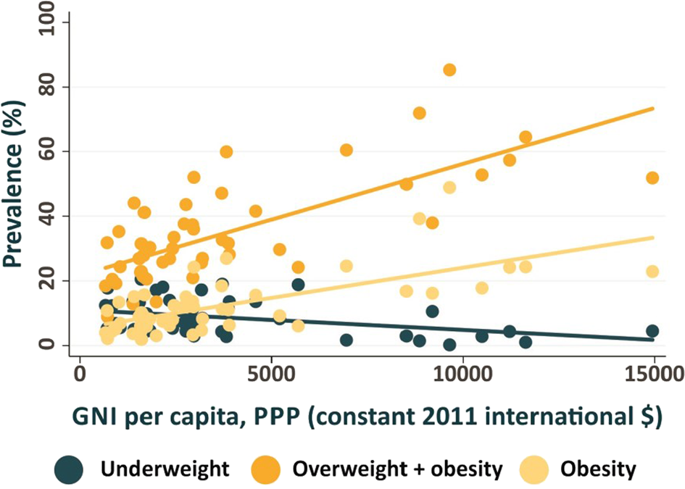当前位置:
X-MOL 学术
›
Int. J. Obesity
›
论文详情
Our official English website, www.x-mol.net, welcomes your feedback! (Note: you will need to create a separate account there.)
Socioeconomic inequalities in the prevalence of underweight, overweight, and obesity among women aged 20-49 in low- and middle-income countries.
International Journal of Obesity ( IF 4.9 ) Pub Date : 2019-12-18 , DOI: 10.1038/s41366-019-0503-0 Ursula Reyes Matos 1 , Marilia Arndt Mesenburg 1 , Cesar G Victora 1
International Journal of Obesity ( IF 4.9 ) Pub Date : 2019-12-18 , DOI: 10.1038/s41366-019-0503-0 Ursula Reyes Matos 1 , Marilia Arndt Mesenburg 1 , Cesar G Victora 1
Affiliation

|
OBJECTIVE
To analyze socioeconomic inequalities in the prevalence of underweight and overweight or obesity in women from low and middle-income countries (LMICs).
METHODS
Using the last available Demographic Health Survey between 2010 and 2016 from 49 LMICs, we estimated the prevalence of underweight (BMI < 18.5 kg/m2) and overweight or obesity combined (BMI ≥ 25 kg/m2) for women aged 20-49 years. We used linear regression to explore the associations between the two outcomes and gross national income (GNI). We assess within-country socioeconomic inequalities using wealth deciles. The slope index of inequality (SII) and the inequality pattern index (IPI) were calculated for each outcome. Negative values of the latter express bottom inequality (when inequality is driven by the poorest deciles) while positive values express top inequality (driven by the richest deciles).
RESULTS
In total, 931,145 women were studied. The median prevalence of underweight, overweight or obesity combined, and obesity were 7.3% (range 0.2-20.5%), 31.5% (8.8-85.3%), and 10.2% (1.9-48.8%), respectively. Pearson correlation coefficients with log GNI were -0.33 (p = 0.006) for underweight, 0.72 (p < 0.001) for overweight or obesity, and 0.66 (p < 0.001) for obesity. For underweight, the SII was significantly negative in 38 of the 49 countries indicating a higher burden among poor women. There was no evidence of top or bottom inequality. Overweight or obesity increased significantly with wealth in 44 of the 49 countries. Top inequality was observed in low-prevalence countries, and bottom inequality in high-prevalence countries.
CONCLUSION
Underweight remains a problem among the poorest women in poor countries, but overweight and obesity are the prevailing problem as national income increases. In low-prevalence countries, overweight or obesity levels are driven by the higher prevalence among the richest women; as national prevalence increases, only the poorest women are relatively preserved from the epidemic.
中文翻译:

中低收入国家20-49岁女性体重不足,超重和肥胖患病率的社会经济不平等现象。
目的分析中低收入国家(LMIC)妇女体重不足,超重或肥胖患病率的社会经济不平等现象。方法使用最近一次可用的2010年至2016年的人口健康调查(来自49个LMIC),我们估算了20-49岁女性的体重不足(BMI <18.5 kg / m2)和超重或肥胖(BMI≥25 kg / m2)的患病率。我们使用线性回归来探讨两个结果与国民总收入(GNI)之间的关联。我们使用财富指标评估国家内部的社会经济不平等。为每个结果计算不平等的斜率指数(SII)和不平等模式指数(IPI)。后者的负值表示最底不平等(当不平等由最贫穷的十等分驱动)时,正值表示最高不等式(由最富有的十分之一驱动)。结果总共对931145名妇女进行了研究。体重过轻,超重或肥胖合并和肥胖的中位患病率分别为7.3%(范围0.2-20.5%),31.5%(8.8-85.3%)和10.2%(1.9-48.8%)。体重不足的Pearson相关系数与log GNI分别为-0.33(p = 0.006),超重或肥胖为0.72(p <0.001)和肥胖为0.66(p <0.001)。就体重不足而言,在49个国家中的38个国家中,SII显着为负,表明贫困妇女的负担更高。没有证据表明最高或最低的不平等。49个国家/地区中有44个国家的超重或肥胖人数显着增加。在低患病率国家中观察到最高的不平等,在高患病率国家中观察到最低的不平等。结论体重不足仍然是贫穷国家最贫穷妇女的问题,但随着国民收入的增加,超重和肥胖是普遍存在的问题。在低患病率国家,超重或肥胖水平是由最富有的妇女中较高的患病率所驱动的;随着全国患病率的上升,只有最贫穷的妇女得以相对远离该流行病。超重或肥胖水平是由最富有的女性中较高的患病率驱动的;随着全国患病率的上升,只有最贫穷的妇女得以相对远离该流行病。超重或肥胖水平是由最富有的女性中较高的患病率驱动的;随着全国患病率的上升,只有最贫穷的妇女得以相对远离该流行病。
更新日期:2019-12-19
中文翻译:

中低收入国家20-49岁女性体重不足,超重和肥胖患病率的社会经济不平等现象。
目的分析中低收入国家(LMIC)妇女体重不足,超重或肥胖患病率的社会经济不平等现象。方法使用最近一次可用的2010年至2016年的人口健康调查(来自49个LMIC),我们估算了20-49岁女性的体重不足(BMI <18.5 kg / m2)和超重或肥胖(BMI≥25 kg / m2)的患病率。我们使用线性回归来探讨两个结果与国民总收入(GNI)之间的关联。我们使用财富指标评估国家内部的社会经济不平等。为每个结果计算不平等的斜率指数(SII)和不平等模式指数(IPI)。后者的负值表示最底不平等(当不平等由最贫穷的十等分驱动)时,正值表示最高不等式(由最富有的十分之一驱动)。结果总共对931145名妇女进行了研究。体重过轻,超重或肥胖合并和肥胖的中位患病率分别为7.3%(范围0.2-20.5%),31.5%(8.8-85.3%)和10.2%(1.9-48.8%)。体重不足的Pearson相关系数与log GNI分别为-0.33(p = 0.006),超重或肥胖为0.72(p <0.001)和肥胖为0.66(p <0.001)。就体重不足而言,在49个国家中的38个国家中,SII显着为负,表明贫困妇女的负担更高。没有证据表明最高或最低的不平等。49个国家/地区中有44个国家的超重或肥胖人数显着增加。在低患病率国家中观察到最高的不平等,在高患病率国家中观察到最低的不平等。结论体重不足仍然是贫穷国家最贫穷妇女的问题,但随着国民收入的增加,超重和肥胖是普遍存在的问题。在低患病率国家,超重或肥胖水平是由最富有的妇女中较高的患病率所驱动的;随着全国患病率的上升,只有最贫穷的妇女得以相对远离该流行病。超重或肥胖水平是由最富有的女性中较高的患病率驱动的;随着全国患病率的上升,只有最贫穷的妇女得以相对远离该流行病。超重或肥胖水平是由最富有的女性中较高的患病率驱动的;随着全国患病率的上升,只有最贫穷的妇女得以相对远离该流行病。



























 京公网安备 11010802027423号
京公网安备 11010802027423号